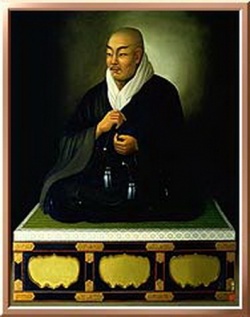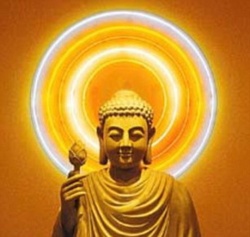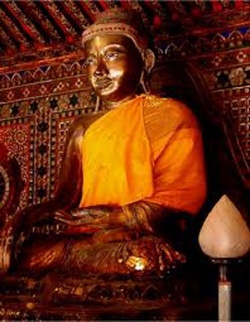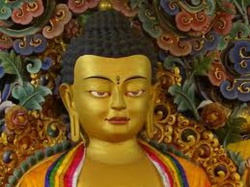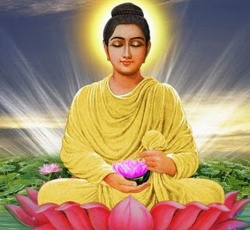Shinran Shonin
Shinran Shonin (1173-1262) was the founder of Shin Buddhism. He was born at the close of the Heian period, when political power was passing from the imperial court into the hands of warrior clans. It was during this era when the old order was crumbling, however, that Japanese Buddhism, which had been declining into formalism for several centuries, underwent intense renewal, giving birth to new paths to enlightenment and spreading to every level of society.
Shinran Shonin was the founder of Shin Buddhism.
Shinran (親鸞?, May 21, 1173 – January 16, 1263) was a Japanese Buddhist monk, who was born in Hino (now a part of Fushimi, Kyoto) at the turbulent close of the Heian Period and lived during the Kamakura Period. Shinran was a pupil of Hōnen and the founder of what ultimately became the Jōdo Shinshū sect in Japan.
Biography
Shinran was born on May 21, 1173 to Lord and Lady Arinori, a branch of the Fujiwara clan, and was given the name Matsuwakamaro. Early in Shinran's life his parents both died, so in 1181, Shinran's uncle entered him into Shoren-in temple near present-day Maruyama Park in Kyoto at age 9. He then practiced at Mt. Hiei for the next 20 years of his life. Letters between his wife and daughter indicate that he was a Tendai dōsō (堂僧?, "hall monk"). Because of his devotion to the practices of the Lotus Sutra on Mt. Hiei, he became known as "the prodigy of Mt. Hiei."
According to his own account to his wife Eshinni (whose letters are preserved at the Hongan-ji), in frustration at his own failures as a monk and at obtaining enlightenment, he took a retreat at the temple of Rokkaku-dō. There, while engaged in intense practice, he experienced a vision in which Avalokitesvara appeared to him as Prince Shōtoku, directing Shinran to another disillusioned Tendai monk named Hōnen. In 1201, Shinran met Hōnen and became his disciple. During his first year under Honen's guidance, at the age of 29, Shinran attained enlightenment, or salvation through Amida's Vow. Though the two only knew each other for a few years, Hōnen entrusted Shinran with a copy of his secret work, the Senchakushū. However his precise status amongst Honen's followers is unclear as in the Seven Article Pledge, signed by Honen's followers in 1204, Shinran's signature appears near the middle among less-intimate disciples.
In 1207, The Buddhist establishment in Kyoto persuaded the military to impose a nembutsu ban, after an incident where two of Hōnen's most prominent followers were accused of using nembutsu practice as a coverup for sexual liaisons. These two monks were subsequently executed. Hōnen and Shinran were exiled, with Shinran being sent to Echigo Province (contemporary Niigata Prefecture). They never met each other again. Hōnen would die later in Kyoto in 1212.
Although Shinran was critical of the motivations that ultimately led to the exile, and the disruption of Hōnen's practice community, the exile itself proved to be a critical turning point in Shinran's religious life. Having been stripped of his monastic name, he renamed himself Gutoku or "foolish, bald-headed one," coming to understand himself as neither monk nor layman. While in exile, Shinran sought to continue the work of Hōnen and spread the doctrine of salvation through Amida Buddha's compassion, as expressed through the nembutsu practice, however in time his teachings diverged from Hōnen enough that later followers would use the term Jōdo Shinshū or "True (Essence of the] Pure Land Sect", as opposed to Jōdo-shū or "Pure Land Sect".
Shinran married his wife, Eshinni, and had six children with her. His eldest son, Zenran, returned to Echigo promising to resolve conflicts there but instead attempted to establish a new sect of his own, claiming to have received special teachings from Shinran. After Shinran wrote a stern letter warning Zenran, who refused, Zenran was disowned and his heretical sect collapsed.
Five years after being exiled in Echigo, in 1211, the nembutsu ban was lifted and Shinran was pardoned though he chose not to return to Kyoto at that time. Instead, Shinran left for an area known as Inada, a small area in Kantō just north of Tokyo. In 1224 Shinran authored his most significant text, Kyogyoshinsho, which is a series of selections and commentaries on Buddhist sutras supporting the new Pure Land Buddhist movement, and establishing a doctrinal lineage with Buddhists thinkers in India and China. In 1234 Shinran left the Kantō area and returned to Kyoto, with his daughter Kakushinni, where he died in the year 1263 at the age of 90. Kakushinni was instrumental in maintaining the mausoleum, and passing on his teachings, with her descendants ultimately becoming the Monshu, or head of the Honganji Temples built around the Mausoleum.
Timeline
1173 Shinran is born
1175 Hōnen founds the Jōdo-shū sect
1181 Shinran becomes a monk
1201 Shinran becomes a disciple of Hōnen and leaves Mt. Hiei
1207 The nembutsu ban and Shinran's exile
1211 Shinran is pardoned
1212 Hōnen passes away in Kyoto & Shinran goes to Kantō
1224 (?) Shinran authors Kyogyoshinsho
1234 (?) Shinran goes back to Kyoto
1256 Shinran disowns his son Zenran
1263 Shinran dies in Kyoto
Doctrine
Essentially Shinran said that because we are all defiled by greed, hatred and delusion, we have no chance of gaining enlightenment by ourselves. Many Buddhists at that time felt that the Dharma of the Buddha had declined to such a point that people could not do it themselves anymore, a concept called mappo in Japanese, a Mahayana eschatology that claims that the ability to practice Dharma properly declines over time. Instead the Pure Land School of Buddhism encouraged its practitioners to rely on the vow of the Buddha Amitabha (Sanskrit, Amida in Japanese) to save all beings from suffering. According to three particular sutras Amitabha vowed to ensure that anyone who chanted his name would be reborn in his Pure Land of Sukhavati (Sanskrit, lit. Land of Bliss) and once there would easily be able to gain enlightenment, because they would not be hindered by the problems of day-to-day life.
Shinran's innovation in Pure Land Buddhism was to take this teaching to its logical extreme. He taught that awakening to the saving grace of Amida Buddha is the central matter. Continuous chanting of the nembutsu (namu amida butsu), is not necessary, as Hōnen, his mentor, had believed. Instead, Shinran taught his followers that the nembutsu should be said as a form of gratitude rather than a way of achieving rebirth in the Pure Land. Faith in Amida Buddha would lead to a deep spiritual awakening, called shinjin, which severs the practitioner forever from birth and death in the world of samsara, and erases karma accumulated through many rebirths. Shinran taught that the advantage of the Path of the Nembutsu can be experienced here and now. This was summed up by Shinran in the four Chinese characters of "Heizei Gojo" which means "Complete the Great Task while alive." Shinran taught that the "Great Task," or the purpose of human life, was to achieve salvation from Amida in this life. Without salvation by Amida in this life there could be no salvation after death, he taught. The arising of shinjin also assures the devotee of birth in the Pure Land, and the attainment of enlightenment there.
Another aspect of Shinran's doctrine was the emphasis on gratitude and humility. Thus, Shinran taught that it was important to be humble and thankful for one's life. This gratitude could be expressed through the nembutsu, but also through a general sense of appreciation.
Over the course of his life, Shinran read the Complete Sutras five times, and, as stated in his short book "Shoshinge" (True Faith Hymn), he came to the conclusion that Sakyamuni's appearance in this world was for the sole purpose of teaching Amida's Vow. Throughout his life Shinran let it be known that he never taught anything other than what Sakyamuni Buddha taught in the sutras.
Statue
A statue of Shinran Shonin stands in Upper West Side Manhattan, in New York City. Located on Riverside Drive between 105th and 106th Streets, in front of the New York Buddhist Temple, the statue depicts Shinran in a peasant hat and sandals, holding a wooden staff, as he peers down on the sidewalk.
Although this kind of statue is often found at Jōdo Shinshū temples, the statue is notable because it survived the atomic bombing of Hiroshima, standing a little more than a mile from ground zero. It was brought to New York in 1955. The plaque calls the statue “a testimonial to the atomic bomb devastation and a symbol of lasting hope for world peace.”
Ashes
On March 14, 2008, what are assumed to be some of the ash remains of Shinran were found in a small wooden statue at the Jōrakuji temple in Shimogyō-ku, Kyōto. The temple was created by Zonkaku (1290–1373), the son of Kakunyo (1270–1351), one of Shinran's great grandchildren. Records indicate that Zonkaku inherited the remains of Shinran from Kakunyo. The 24.2 cm wooden statue is identified as being from the middle of the Edo period. The remains were wrapped in paper.
Life of Inspiration
Shinran was born into the Hino family and his father at one time served at court. At the age of nine, however, Shinran entered the Tendai temple on Mt. Hiei, where he spent twenty years in monastic life. From the familiarity with Buddhist writings apparent in his later works, it is clear that he exerted great effort in his studies during this period. He probably also performed such practices as continuous recitation of the nembutsu for prolonged periods.
Conversion
After twenty years, however, he despaired of ever attaining awakening through such discipline and study; he was also discouraged by the deep corruption that pervaded the mountain monastery. Years earlier, Honen Shonin (1133-1212) had descended Mt. Hiei and begun teaching a radically new understanding of religious practice, declaring that all self-generated efforts toward enlightenment were tainted by attachments and therefore meaningless. Instead of such practice, one should simply say the nembutsu, not as a contemplative exercise or means of gaining merit, but by way of wholly entrusting oneself to the great compassionate activity of the ultimate dimension, symbolized by Amida's Vow, to bring all beings to enlightenment and spiritual liberation.
When he was twenty-nine, Shinran undertook a long retreat at Rokkakudo temple in Kyoto to determine his future course. At dawn on the ninety-fifth day, Prince Shotoku , the founder of Japanese Buddhism, appeared to him in a dream. Shinran took this as a sign that he should seek out Honen, and went to hear his teaching daily for a hundred days. He then abandoned his former Tendai practices and joined Honen's movement.
Exile
At this time, however, the established temples were growing jealous of Honen, and in 1207 they succeeded in gaining a government ban on his nembutsu teaching. Several followers were executed, and Honen and others, including Shinran, were banished from the capital.
Shinran was stripped of his priesthood, given a layman's name, and exiled to Echigo (Niigata) on the northern hinder lands of the Japan Sea coast. About this time, he married Eshinni and began raising a family. He declared himself "neither monk nor layman." Though incapable of fulfilling monastic discipline or good works, precisely because of this, he was grasped by Amida's compassionate activity. Later, he chose for himself the name Gutoku, "foolish/bald one," indicating the futility of attachment to one's own intellect and goodness.
He was pardoned after five years, but decided not to return to Kyoto. Instead, in 1214, at the age of forty-two, he made his way into the Kanto region, where he spread the nembutsu teaching for twenty years, building a large movement among the peasants and lower samurai.
Return to Kyoto
Then, in his sixties, Shinran began a new life, returning to Kyoto to devote his final three decades to writing. He did not give sermons or teach disciples, but lived with relatives, supported by gifts from his followers in the Kanto area. It is from this period that most of his writings stem. He completed his major work, popularly known as Kyogyoshinsho, and composed hundreds of hymns in which he rendered the Chinese scriptures accessible to ordinary people. His creative energy continued to his death at ninety, and his works manifest an increasingly rich, mature, and articulate vision of human existence that reveals him to be one of the world’s most profound and original religious thinkers. His last words were,
"Though I return to the Pure Land of Eternal Peace after my life is at an end,
Yet shall I return to this world, again and again,
Just as the waves of Wakanoura Bay return to the beach....
When you rejoice in the Nembutsu, consider that two actually rejoice
When you rejoice with another, consider that there are three,
And that other is Shinran…Thank You, Namo Amida Butsu."
